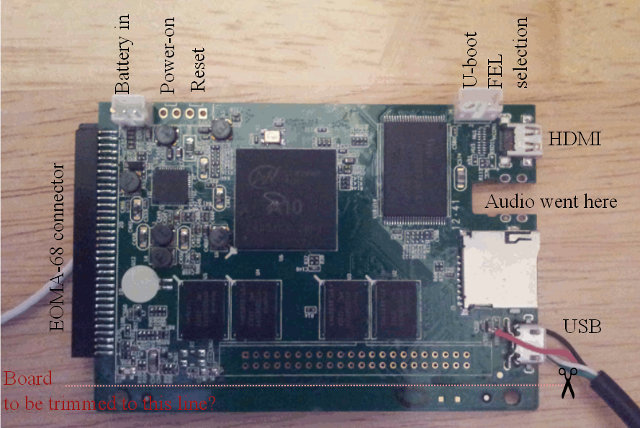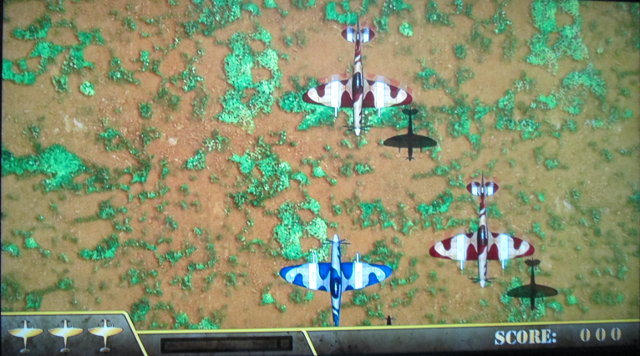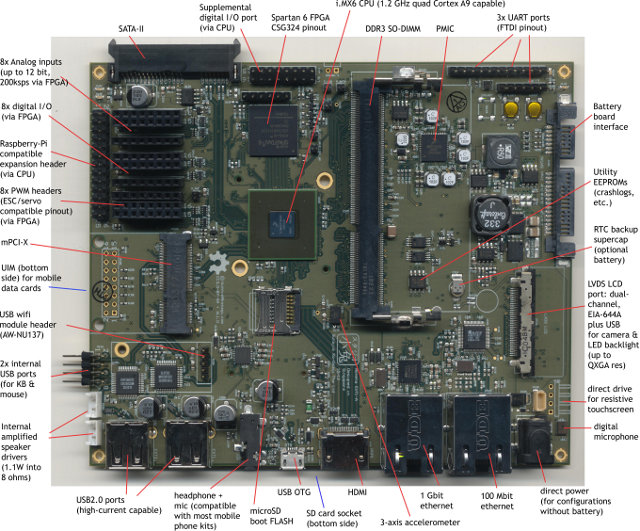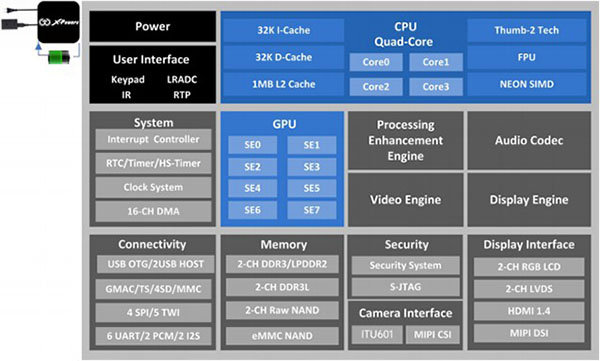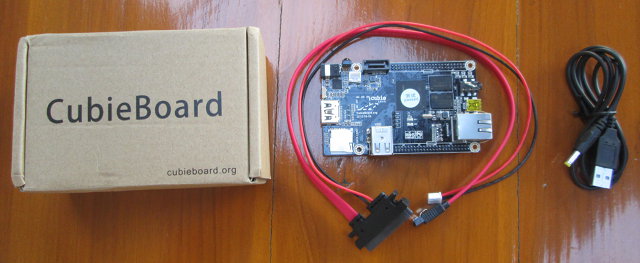Do you remember Rhombus Tech AllWinner A10 EOMA-PCMCIA CPU card that targets a BOM cost of $15 US, that was announced at the end of last year? Well, after much wait, the first prototype is now available. This CPU module is based on AllWinner A10 Cortex A8 processor, with 1GB RAM, a NAND Flash, one USB OTG port, microSD slot, HDMI, PMIC, an Ethernet PHY (at the back), an expansion header, and the EOMA-68 connector giving access to peripherals signals (SATA, Ethernet, RGB/TTL, I2C etc…). It can act as a Linux/Android stand-alone computer or be connected to a baseboard. One of the first project will be a laptop for the Chinese market. AllWinner A10 SoC may be a little underpowered to be used in laptop compared to the latest ARM processors, but since EOMA-PCMCIA is a standard, pin-to-pin compatible modules will eventually be designed and manufactured with different/faster (ARM) processors. […]
libavg on Raspberry Pi
libavg development team has recently announced a beta port of their multimedia library to the Raspberry Pi. libavg is a high-level development platform for media-centric applications using Python as scripting language and written in C++. I came to know this platform as I tried Xibo Digital Signage, and I tested it on ARM platforms. Up to know this would only work using software rendering/decoding, and everything was painfully slow on ARM, but libavg developers are now making use of OpenGL ES to boost graphics speed. More work is needed, and they intend to eventually support features such as hardware video decoding (OpenMAX possibly via gstreamer) and compressed textures. Installing libavg on Raspberry Pi. Pre-built packages are available for Raspberry, so installation is pretty straight forward:
|
1 2 3 4 5 |
sudo apt-get install libxml2 libpango1.0-0 librsvg2-2 libgdk-pixbuf2.0-0 \ libavcodec53 libavformat53 libswscale2 libboost-python1.49.0 \ libboost-thread1.49.0 libsdl1.2debian libxxf86vm1 wget https://www.libavg.de/site/attachments/download/190 -O libavg-raspberry.tar.bz2 sudo tar -C /usr/local -xjf libavg-raspberry.tar.bz2 |
Running Samples Apps 32 samples are located in /usr/local/lib/python2.7/dist-packages/libavg/samples/ directory, and they rely on X11, so first start LXDE:
|
1 |
startx |
Open a serial console (LXTerminal) […]
Build Your Own Freescale i.MX6 Quad Laptop
Andrew Huang (“Bunnie”) and others have been working on an open source laptop based on Freescale i.MX6 Quad processor since June, and they’ve recently got the motherboard. Beside featuring a powerful quad core ARM processor, the design files are also provided, so if you have the right skills and resources you can build it yourself. The open source laptop mainboard (Codename: Novena) has the following specifications: SoC – Freescale iMX6 Quad @ 1.2GHz with Vivante GC2000 GPU System Memory – 64-bit DDR3-1066 SO-DIMM, upgradable to 4GB Storage – microSD boot flash, SATA-II connector for hard drive / SSD, SD card reader and serial EEPROM (for storing crash logs and other bits of handy data). FPGA – Spartan-6 CSG324. It has several interfaces to the CPU, including a 2Gbit/s RAM-like bus. Internal ports & sensors: mini PCI-express slot UIM slot for mPCIx mobile data cards Dual-channel LVDS LCD connector (up to […]
SliTaz armhf: 46MB Linux Distribution for Raspberry Pi
SliTaz armhf is a minimal Linux distribution based on SliTaz Linux, that uses the hard-float ABI for the Raspberry Pi. The compressed SD card image is 46M, the rootfs 18.6 MB, and Slitaz uses just about 7 MB RAM after boot. Slitaz armhf rootfs comes pre-loaded with the following packages: busybox 1.20.2 dropbear 2012.55 – Light SSH client and server. nano 2.2.6 – GNU Nano Text Editor. retawq 0.2.6c – Text mode Web browser. tazpkg 5.0 – SliTaz packages manager (Tiny autonomous zone packages manager). ytree 1.97 – file manager for file and archives. Slitaz armhf comes with tazpkg package manager which allows to install packages just like you would do with apt-get in Raspbian. There are over 3,300 packages available for Slitaz (x86), and for now, over 250 packages are available for Slitaz armhf. Let’s get try it out. First, download slitaz-armhf-mini-2012-12-14.zip, extract it, and copy it to an […]
Running Ubuntu in Android with ODROID-X Development Board
I’ve had several people asking me about running Linux on Android in the last few months, but I did not look into it into details, because I thought we would just be able to run server apps. That is until Rohith left a comment on CNX Software Facebook timeline, that it’s possible to run Linux in Android, and access the user interface via VNC (sort of simple, but I did not think of it). You probably need at least 1GB of memory and a multi-core processor to run this sort of setup correctly, so I finally decided to give it a try by running Ubuntu 12.04 with Unity interface in ODROID-X development board. I mainly followed the instructions available at http://linuxonandroid.org/ and inside the Android app. Most of the steps I followed can also be replicated on other rooted Android hardware platforms. Apart from Ubuntu 10.04 & 12.04, you can […]
Linux 3.7 Release
Linus Torvalds has announced the release of Linux Kernel 3.7: Whee. After an extra rc release, 3.7 is now out. After a few more trials at fixing things, in the end we ended up reverting the kswapd changes that caused problems. And with the extra rc, I had decided to risk doing the buffer.c cleanups that would otherwise have just been marked for stable during the next merge window, and had enough time to fix a few problems that people found there too. There’s also a fix for a SCSI driver bug that was exposed by the last-minute workqueue fixes in rc8. Other than that, there’s a few networking fixes, and some trivial fixes for sparc and MIPS. Anyway, it’s been a somewhat drawn out release despite the 3.7 merge window having otherwise appeared pretty straightforward, and none of the rc’s were all that big either. But we’re done, and […]
AllWinner Publishes A31 and A20 Processors Details
Several tablets based on AllWinner A31 quad core processor have been announced this week, such as Onda V972, but we did not really have full details on the processor. We now know more since AllWinner added product pages for two new (sun6i architecture. [Edit: A20 is actually sun7i…]) processors: AllWinner A31 and AllWinner A20. AllWinner A31 Specifications AllWinner A31 is a quad core Cortex A7 processor with PowerVR SGX544MP2 GPU (8 shader engines). CPU – ARM Cortex-A7 Quad-Core with 256KB L1-Cache/1MB L2-Cache GPU – POWER VR SGX 544 with Eight logic cores. Open GL ES2.0, Open CL1.x and DX 9_3 compliant. Memory – Dual-Channel LPDDR2/DDR3/DDR3L Controller, Dual-Channel NAND FLASH Controller and 64-bit ECC Video UHD H.264 4K ×2K @30fps video decoding Full HD video decoding BD Directory, BD ISO and BD m2ts video decoding H.264 High Profile 1080P@60fps encoding 3840×1080@30fps 3D decoding Complies with RTSP, HTTP, HLS, RTMP, MMS streaming […]
Cubieboard Unboxing and Quick Start Guide
I’ve received another cool board this week with the Cubieboard development board. As a quick reminder, the Cubieboard is the only proper low cost AllWinner A10 development board available, and comes with 512MB/1GB RAM, 4GB NAND Flash, 10/100 MBit Ethernet, HDMI output, 2x USB Host port, 1x USB OTG port, a microSD socket, a SATA interface, an IR sensor and 2 headers to access extra pins such as GPIOs, I2C, SPI,VGA pins, CVBS pins etc… CubieTech had a successful Indiegogo campaign where the 1GB board was available for $59 including worldwide shipping (and as low as $19 for early birds), and you can now buy it from resellers. [Update: It’s now available with several cables, USB to TTL debug board, and an enclosure for $80 on dx.com] Cubieboard Unboxing The board comes with a SATA cable and a USB cable for power. There’s no power supply so you’ll need you […]


